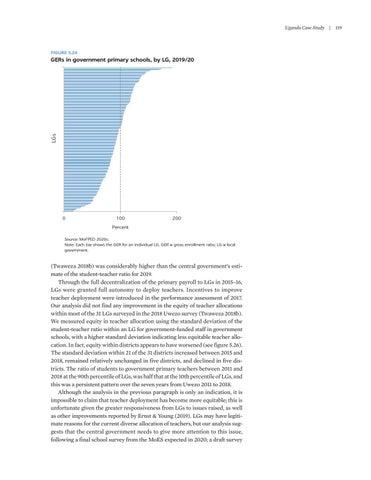Uganda Case Study | 119
FIGURE 5.24
LGs
GERs in government primary schools, by LG, 2019/20
0
100
200
Percent Source: MoFPED 2020c. Note: Each bar shows the GER for an individual LG. GER = gross enrollment ratio; LG = local government.
(Twaweza 2018b) was considerably higher than the central government’s estimate of the student-teacher ratio for 2019. Through the full decentralization of the primary payroll to LGs in 2015–16, LGs were granted full autonomy to deploy teachers. Incentives to improve teacher deployment were introduced in the performance assessment of 2017. Our analysis did not find any improvement in the equity of teacher allocations within most of the 31 LGs surveyed in the 2018 Uwezo survey (Twaweza 2018b). We measured equity in teacher allocation using the standard deviation of the student-teacher ratio within an LG for government-funded staff in government schools, with a higher standard deviation indicating less equitable teacher allocation. In fact, equity within districts appears to have worsened (see figure 5.26). The standard deviation within 21 of the 31 districts increased between 2015 and 2018, remained relatively unchanged in five districts, and declined in five districts. The ratio of students to government primary teachers between 2011 and 2018 at the 90th percentile of LGs, was half that at the 10th percentile of LGs, and this was a persistent pattern over the seven years from Uwezo 2011 to 2018. Although the analysis in the previous paragraph is only an indication, it is impossible to claim that teacher deployment has become more equitable; this is unfortunate given the greater responsiveness from LGs to issues raised, as well as other improvements reported by Ernst & Young (2019). LGs may have legitimate reasons for the current diverse allocation of teachers, but our analysis suggests that the central government needs to give more attention to this issue, following a final school survey from the MoES expected in 2020; a draft survey






